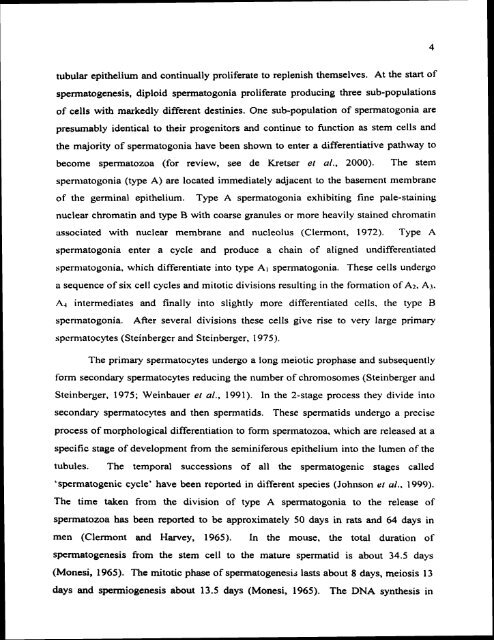ON TESTIS AND EPlDlDYMlS OF RATS - Pondicherry University ...
ON TESTIS AND EPlDlDYMlS OF RATS - Pondicherry University ...
ON TESTIS AND EPlDlDYMlS OF RATS - Pondicherry University ...
You also want an ePaper? Increase the reach of your titles
YUMPU automatically turns print PDFs into web optimized ePapers that Google loves.
tubular epithelium and continually proliferate to replenish themselves. At the start of<br />
spermatogenesis, diploid spermatogonia proliferate producing three sub-populations<br />
of cells with markedly different destinies. One sub-population of spermatogonia are<br />
presumably identical to their progenitors and continue to function as stem cells and<br />
the majority of spermatogonia have been shown to enter a differentiative pathway to<br />
become spermatozoa (for review, see de Kretser er al., 2000). The stem<br />
spern~atogonia (type A) are located immediately adjacent to the basement membrane<br />
of the germinal epithelium. Type A spermatogonia exhibiting fine pale-staining<br />
nuclear chromatin and type B with coarse granules or more heavily stained chromatin<br />
associated with nuclear membrane and nucleolus (Clermont, 1972).<br />
'Type A<br />
spermatogonia enter a cycle and produce a chain of aligned undifferentiated<br />
spermatogonia, which differentiate into type A, spermatogonia. These cells undergo<br />
a sequence of six cell cycles and mitotic divisions resulting in the formation of A2, A>.<br />
A4 intermediates and finally into slightly more differentiated cells, the type B<br />
spermatogonia. After several divisions these cells give rise to very large primary<br />
spcrniatocytes (Steinberger and Steinberger, 1975).<br />
The primary spermatocytes undergo a long meiotic prophase and subsequently<br />
form secondary spermatocytes reducing the number of chromosomes (Steinberger and<br />
Steinberger, 1975; Weinbauer er a/., 1991). In the 2-stage process they dtvide into<br />
secondary spermatocytes and then spermatids. These spermatids undergo a precise<br />
process of morphological differentiation to form spermatozoa, which are released a1 a<br />
specific stage of development from the seminiferous epithelium into the lumen of the<br />
tubules.<br />
The temporal successions of all the spermatogenic stages called<br />
'spermatogenic cycle' have been reported in different species (Johnson rr 01.. 1999).<br />
The time taken from the division of type A spermatogonia to the release of<br />
spermatozoa has been reported to be approximately 50 days in rats and 64 days in<br />
men (Clermont and Harvey, 1965). In the mouse, the total duration of<br />
spermatogenesis from the stem cell to the mature spermatid is about 34.5 days<br />
(Monesi, 1965). The mitotic phase of spermatogenesis lasts about 8 days, meiosis 13<br />
days and spermiogenesis about 13.5 days (Monesi, 1965). The DNA synthesis in

















